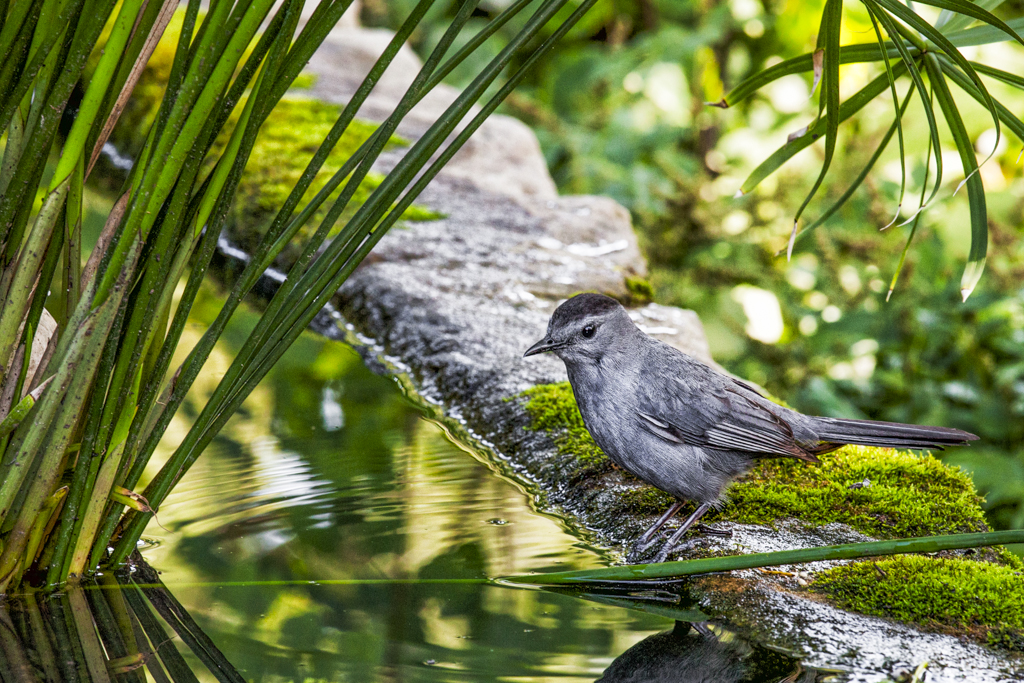“In the catbird seat” is an idiomatic expression in the United States. But is that true anywhere else? I don’t know. Essentially it means “a position of great prominence or advantage” (Merriam-Webster). Regardless, this was a rather unusual expression. What exactly did it mean, I wondered for so many years. Even so I never considered pursuing it until I noticed Catbird, Ohio.
Pardon my ignorance. My initial issue was that I didn’t even know whether a “catbird” was a cat parading as a bird for some maniacal reason or a bird masquerading as a cat. Why would someone mash together the names of two perfectly acceptable yet totally contradictory animals?
There was at least one other feline-fauna combination, catfish, so I realized it wasn’t completely unprecedented. Maybe it wasn’t the weirdest possible combination imaginable like maybe catcow (apparently a yoga pose), although catbird still sounded strange to me.
Dumetella Carolinensis
Birders in the 12MC audience already knew the answer and probably smiled at my pitifully uninformed viewpoint. Catbird was indeed a bird masquerading as a cat.

Catbird Call
Several years ago I took a trip through the Finger Lakes region of New York, using Ithaca as staging point. It was there that I learned of Cornell University’s prominent position in the birder universe. It supported a renowned Lab of Ornithology. Naturally I’ve turned to them as a source of definitive information on rare occasions when 12MC discussed birds. Otherwise I knew next to nothing about the topic. So, from its Gray Catbird page:
“If you’re convinced you’ll never be able to learn bird calls, start with the Gray Catbird. Once you’ve heard its catty mew you won’t forget it. Follow the sound into thickets and vine tangles and you’ll be rewarded by a somber gray bird with a black cap and bright rusty feathers under the tail. Gray Catbirds are relatives of mockingbirds and thrashers, and they share that group’s vocal abilities, copying the sounds of other species and stringing them together to make their own song.”
Catbird Range
Gray Catbirds range from Central America, up along the eastern coast of Mexico, across most of the United States except the southwest, and then the complete southern rim of Canada (where something like 75% of Canadians live). The International Union for Conservation of Nature defined Gray Catbird — Dumetella carolinensis — as a species of “least concern“. Gray Catbirds exhibited a stable population and an extremely large range. Chances were good that anyone in the 12MC audience from North America lived amongst catbirds. However, like myself, most of us probably never really thought about it before.
There were several other distantly related and unrelated groups of birds worldwide also called catbirds because of their catty calls. Most of them live in Australia plus one in Central America and another in Ethiopia. I focused on the Gray Catbird because the expression “in the catbird seat” likely originated within the United States.
The Thurber Connection
So James Thurber wrote a short story called “The Catbird Seat” in 1942. It appeared in The New Yorker magazine.
“It was Joey Hart, one of Mr. Martin’s two assistants, who had explained what the gibberish meant. ‘She must be a Dodger fan,’ he had said. ‘Red Barber announces the Dodger games over the radio and he uses those expressions – picked ’em up down South.’ Joey had gone on to explain one or two… ‘sitting in the catbird seat’ means sitting pretty, like a batter with three balls and no strikes on him.”
I won’t give away the ending except to note that the catbird expression figured prominently in the climax. You should read it yourself — it won’t take more than about ten minutes — and come back when your done.
The Barber Connection
Walter Lanier (“Red”) Barber “was one of the first two broadcasters honored by the National Baseball Hall of Fame“. He was born in Mississippi in 1908, became a pioneering sports broadcaster and was considered by many as “the first reporter to broadcast baseball” rather than simply announce the games. He served as the “voice of the Brooklyn Dodgers” from 1939 to 1953. Barber carried along folksy colloquialisms he’d acquired during his travels and used them as he called games. Most famously he used “in the catbird seat”. He even titled his 1968 autobiography Rhubarb in the Catbird Seat.
Barber and Thurber popularized the expression. The history of catbird seat prior to their usage was murky at best (e.g., Phrase Finder and Etymology Online). Barber claimed he’d first heard it spoken in Cincinnati years earlier. It came from the boastful winner of a hand of poker that Barber had just lost. Lots of different birds perched in treetops so the question remained, why the catbird? It’s a mystery.
Catbird as a Placename
Catbird, Ohio was the only populated place in the United States with that name. It applied a settlement and the former site of a collocated school. There were also two inconsequential streams with the name, one in Maryland and one in Tennessee.
Interestingly, the Catbird settlement was maybe 75 miles (120 km) upstream on the Ohio River from Cincinnati. That’s the city where Red Barber claimed he’d first heard the expression. I found no further information about the town other than a soil survey taken by the U.S. Dept. of Agriculture in the 1930’s: “A colluvial phase of Huntington silt loam occurs along Ohio Brush Creek along Moore Run and Beasley Fork east of Catbird School and along a number of small creeks north of West Union.”
Maybe there was an historical abundance of catbirds along the southwestern Ohio stretch of the river. Maybe people were predisposed to use catbird in an expression like someone elsewhere might have used sparrow, pigeon, starling or robin. Nobody knows.

Leave a Reply